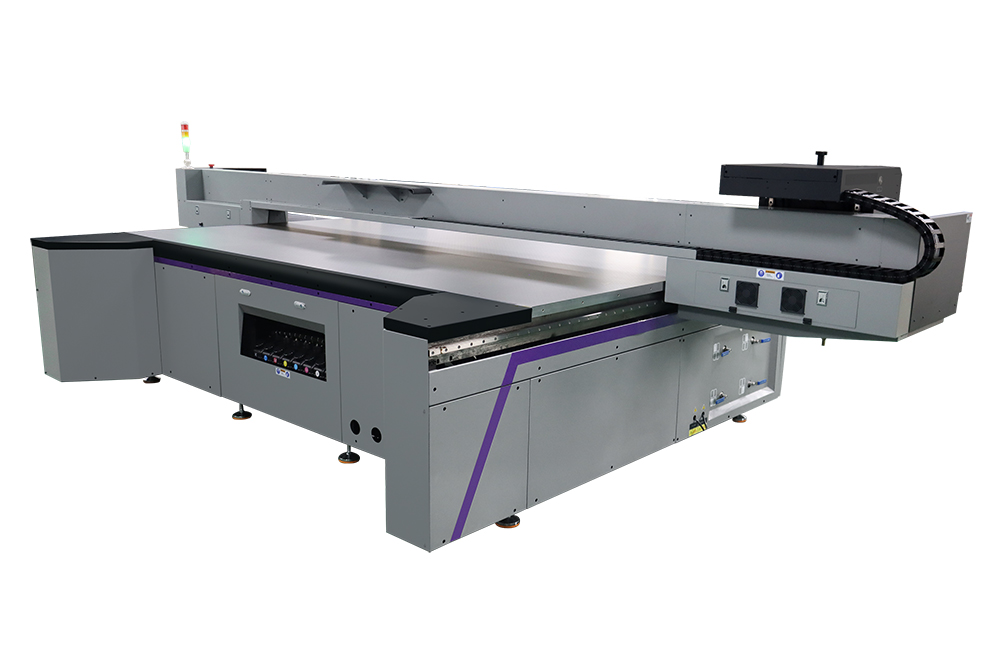Technical Overview of a UV Flatbed Printer
Technical Overview of a UV Flatbed Printer
Introduction
UV Flatbed Printer, also known as UV Flatbed Printer or Universal Flatbed Printer, is a revolutionary technology that has transformed the printing industry. It represents a significant breakthrough in digital printing, offering unparalleled flexibility, precision, and efficiency. This article provides a technical overview of the UV Flatbed Printer, exploring its workings, advantages, applications, and the impact it has had on various industries.

Basics and Working Principle
UV Flatbed Printers combine the principles of inkjet printing with UV curing technology. The printer consists of three primary systems: the vacuum adsorption system, the ink supply system, and the electrical system. The vacuum adsorption system ensures that the material to be printed remains firmly in place during the printing process. The ink supply system delivers UV-curable ink to the printheads, while the electrical system controls the entire operation.
The working principle of a UV Flatbed Printer can be summarized in the following steps:
File Preparation: The design is created on a computer and converted into a specific file format (such as PostScript or PDF) suitable for printing.
Print Settings: The desired print quality, speed, and resolution are set on the printer’s control panel.
Material Preparation: The flat material to be printed is placed on the printer’s worktable, ensuring it is clean and flat.
Printing: The printheads, carrying UV-curable ink, move along the X and Y axes of the material, precisely depositing ink droplets.
UV Curing: As soon as the ink is deposited, UV light is emitted, curing the ink instantly. This process is extremely fast, often completing within milliseconds.
Completion: Once all ink droplets have been cured, the printing process is complete, leaving a high-quality, durable print on the material.
Advantages of UV Flatbed Printers
High Precision and Resolution
UV Flatbed Printers offer exceptional print quality, with resolutions up to 2880 dpi and the ability to print fine details as small as 1.5 picoliters. This level of precision allows for the reproduction of photographs, intricate designs, and small fonts with outstanding clarity and color accuracy.
Versatility in Materials
One of the primary advantages of UV Flatbed Printers is their ability to print on a wide range of materials. These include metals (such as gold, silver, copper, and aluminum), plastics, glass, ceramics, wood, leather, textiles, and even silicone. This versatility makes them ideal for various industries, including advertising, packaging, decoration, and product prototyping.
Cost-Effective and Efficient
UV Flatbed Printers eliminate the need for plates or screens, making them significantly more cost-effective for short-run and custom jobs. They can print single sheets as efficiently as large batches, making them ideal for on-demand printing and rapid prototyping. Additionally, the UV curing process is fast, reducing production time and increasing overall efficiency.
Environmentally Friendly
UV curing technology significantly reduces the environmental impact of printing. Unlike traditional solvent-based inks, UV inks do not emit volatile organic compounds (VOCs) during the curing process. This makes UV Flatbed Printers a more environmentally friendly alternative, complying with stricter environmental regulations.
Key Features and Innovations
LED UV Curing System
Modern UV Flatbed Printers utilize LED UV curing systems, which offer several advantages over traditional UV lamps. LEDs emit less heat, reducing the risk of material warping or damage. They also have a longer lifespan and consume less energy, reducing operating costs. The LED UV curing system allows for the creation of impressive 3D textured and raised printing effects, enhancing the visual appeal of prints.
Automatic Height Adjustment
To accommodate materials of varying thicknesses, UV Flatbed Printers feature automatic height adjustment mechanisms. These ensure that the printheads maintain a constant distance from the material surface, resulting in consistent print quality across different media types.
Intelligent Ink Management
Advanced UV Flatbed Printers incorporate intelligent ink management systems that monitor ink levels and automatically adjust printing parameters to optimize ink usage. This not only reduces waste but also ensures consistent print quality over extended periods.
Applications
UV Flatbed Printers have found applications in numerous industries, revolutionizing the way products are designed, prototyped, and produced.
Advertising and Marketing
In the advertising industry, UV Flatbed Printers are used to create eye-catching signage, banners, and promotional materials. Their ability to print on various materials allows for highly customized and impactful designs.
Packaging
The packaging industry benefits from UV Flatbed Printers’ versatility and precision. They can print directly onto boxes, bottles, and other packaging materials, allowing for personalized branding and high-quality graphics.
Industrial Design and Prototyping
Designers and engineers rely on UV Flatbed Printers for rapid prototyping and product development. The printers’ ability to print on a wide range of materials and produce high-resolution prints enables the creation of detailed and accurate prototypes.
Personalization and Customization
UV Flatbed Printers are perfect for personalization and customization, from phone cases and t-shirts to home decor and gifts. They offer a cost-effective way to produce small batches of unique items, meeting the growing demand for personalized products.
Conclusion
UV Flatbed Printers represent a significant advancement in digital printing technology, offering unparalleled precision, versatility, and efficiency. Their ability to print on a wide range of materials and produce high-quality prints makes them ideal for various industries, from advertising and packaging to industrial design and personalization. With their environmentally friendly UV curing technology and cost-effective operation, UV Flatbed Printers are poised to continue revolutionizing the printing industry for years to come.
As technology continues to evolve, we can expect further innovations in UV Flatbed Printers, such as increased speed, improved resolution, and enhanced material compatibility. These advancements will undoubtedly expand the printers’ applications and solidify their position as a vital tool in modern manufacturing and design processes.
